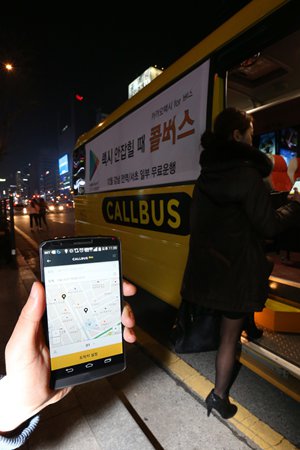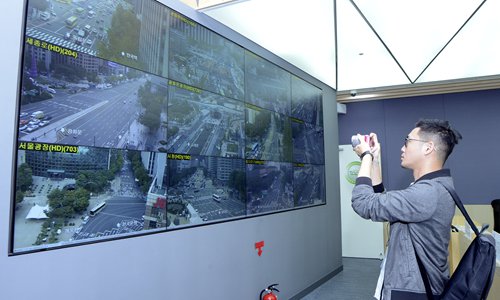Technology adds comfort
By Joyce Bi in Seoul Source:Global Times Published: 2019/11/7 16:18:40

Children explore an unmanned bus with fascination in Beijing. Photo: IC

A passenger gets on a bus near a subway station in the Gangnam Ward of Seoul, South Korea, early 24 December 2015, as she uses a public ride sharing transportation service, Call-A-Bus, after entering her origin and destination on a smartphone app. Photo: IC

Yang Youn-gye of the Transportation Information Center speaks at presentation during a foreign press visit to the center on September 27. Photo: Bi Mengying/GT

Visitor takes photos of real-time videos at TOPIS in Seoul on September 27. Photo: Courtesy of TOPIS
Sweaty, jammed, ergo, a little bit grumpy, maybe? There are roughly 20 subway lines and more than 1,200 bus routes in Beijing. Still, if you successfully get through in your daily commute in the grand capital of the most populous country, you are a survivor.
Around 6.1 million people use public transportation on a daily basis during the weekdays in the city, according to reports released by Beijing Transport Institute in August. Inside the city's sixth ring road, the average commute time is 56 minutes.
Local authorities have been putting continuous efforts to improve the situation. Recently, Beijing Public Transport announced plans to implement facial recognition technology to comply with passengers' travel demand and to develop a real-time, accurate and efficient management and control system of intelligent transportation. While these surely are great pieces of news for the city's army of commuters, the city still has reasons to look toward its neighboring country's capital-Seoul for pointers.
Inside Seoul's City Hall, the control center of TOPIS (Transport Operation & Information Service) is responsible for operating and managing Seoul's overall traffic. According to its official website, TOPIS does this by collecting traffic information from the Bus Management System (BMS), the Transport Card System, the unmanned surveillance system, including other traffic-related authorities and institutions such as Seoul Traffic Broadcasting, Seoul Metropolitan Police Agency, and the Korea Expressway Corporation.
"This place is not open to the public. We have been receiving high-profile international figures and even heads of states," said Yang Youn-gye of the Transportation Information Center during a foreign press visit to the center in September.
While rows of computers and screens streamed various real-time traffic feeds from across the city, few people were seen working at the office. The officers can work from home using their personal computers to obtain and analyze the data. Unless it's emergency, they don't need to come in.
Numerous cameras are strategically mounted across the city, so the center can get real-time videos and information about road constructions, events, and accidents enabling better management of the overall traffic. And the resolutions of the cameras are extremely high, said Yang as he zoomed in on a wishing well at a square in the city's center. Just by glaring at the screen, the values of these coins in the well could be determined. These high-definition cameras help to spot illegal parking and over speeding cars, thereby making them liable for penalties.
Besides, any sudden movements also trigger the camera sensors, and the camera adjusts the focus accordingly so that officers can decide whether there's any need for emergency response.
To make it even better, the citizens can gain access to most of the data on their mobile phone through an app. "Through the app, you'd be able to see how many people get on and off a certain bus, and how many buses are in operation. The data is updated every minute…If the buses are too crowded, the control center will deploy more buses for passengers," said Yang.
Similarly, the app of Beijing's bus service is also mulling a function to solve the crowding issues soon. The crowding inquiry function will cover 90 percent of the bus routes in Beijing, and related data will be collected through bus card readers. There will be three levels, on the app, depending on the crowd that will be demarcated with the colors—green, yellow and red. Green represents spacious with seats available, yellow means relatively crowded and red is very crowded, according to media reports. While this information can provide travel references to passengers, the data can also be used by the relevant public transport departments to increase temporary buses.
Punctuality of buses is now one area that Beijing Public Transport aims to improve with significant efforts. Media reports noted that 1,200 electronic bus stop signs will be set up to monitor and report the buses' arrival time. For some lines, the interval of buses is expected to be shortened close to one minute.
In Seoul's Quasi-public Bus Operation project, to ensure punctuality and even intervals, the city moved bus lanes from the roadside to the central lanes by creating an exclusive median lane for the city buses, supposedly to avoid any disturbance caused by vehicles that usually pull over on the side, something that Beijing can also emulate.
Posted in: CULTURE & LEISURE,BIZ FOCUS